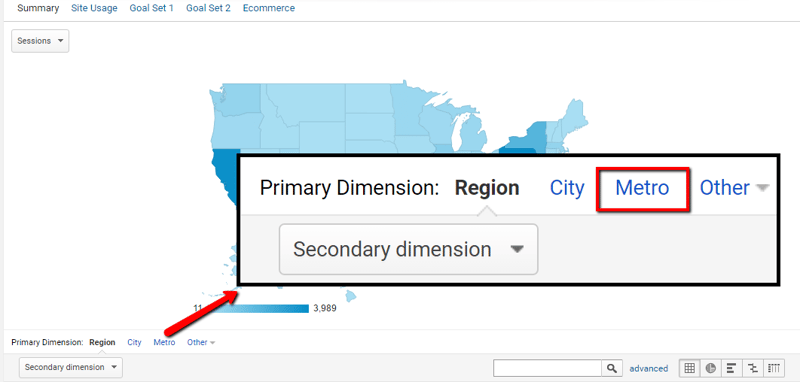Gain Thorough Viewpoints With Additional Dimension in Google Analytics
Secondary measurements in Google Analytics act as a powerful tool for enhancing the depth of understandings obtained from data evaluation. Keep tuned to find just how secondary measurements can change your information analysis and drive educated decision-making in the digital realm.
Recognizing Second Measurements in GA
The concept of secondary dimensions in Google Analytics boosts data evaluation by supplying additional insights right into key metrics. Additional measurements enable individuals to dive deeper right into their information by adding an extra layer of information to the primary information being assessed. By integrating additional measurements, individuals can segment and contrast data throughout various dimensions, such as website traffic sources, customer gadgets, geographical places, and more. This added level of granularity makes it possible for a more extensive understanding of individual behavior and web site performance.
Understanding how to properly make use of second measurements in Google Analytics is important for drawing out useful understandings from the information accumulated. By picking the proper secondary measurements to match main metrics, individuals can uncover patterns, patterns, and connections that may have otherwise gone undetected. This deeper degree of analysis can result in even more educated decision-making and the optimization of digital advertising and marketing strategies to boost overall efficiency.
Advantages of Using Secondary Dimensions
Discovering the advantages intrinsic in leveraging secondary dimensions within Google Analytics brightens the deepness of insights offered for enhancing information analysis. By integrating secondary measurements, customers can get an extra thorough understanding of their key information metrics.
Furthermore, secondary dimensions make it possible for customers to contrast and contrast various data points within the very same report, offering an extra holistic view of web site performance. This relative analysis can clarify the effectiveness of advertising and marketing projects, content engagement, or individual demographics. Additionally, the usage of secondary dimensions can aid in determining outliers or abnormalities that may need additional examination.
Fundamentally, leveraging additional dimensions in Google Analytics supplies an effective tool for removing important insights and maximizing data-driven decision-making procedures.
Carrying Out Additional Measurements Effectively
To properly apply second dimensions in Google Analytics, planning the selection and application of these added data layers is paramount for taking full advantage of the deepness of insights acquired from analytics records. When choosing additional measurements, think about the details objectives of your evaluation to guarantee the chosen dimensions straighten with the information needed to answer relevant concerns. It's vital to focus on relevance over amount, picking dimensions that match the primary measurement and give purposeful context.
Implementing secondary measurements properly involves utilizing them to uncover patterns, trends, and relationships that may not be evident when evaluating data solely based on the key measurement. By incorporating secondary dimensions thoughtfully, you can boost the granularity of your evaluation and gain deeper insights right into individual actions, content performance, and various other essential metrics within Google Analytics.
Analyzing Data With Secondary Measurements
Utilizing second dimensions in information evaluation gives a nuanced point of view that discovers detailed partnerships and patterns within Google Analytics reports. By incorporating secondary measurements along with main measurements, experts can delve deeper right into the information to draw out beneficial understandings. When evaluating data entirely based on key dimensions., this approach allows the recognition of relationships that may not be promptly apparent.
When assessing data with additional measurements in Google Analytics, it is important to consider the certain metrics or measurements that will certainly supply one of the most meaningful context for the primary measurement being analyzed. Combining the main measurement of 'traffic resource' with secondary dimensions such as 'tool classification' or 'touchdown page' can offer a more comprehensive understanding of individual behavior and choices.
In addition, the capability to section information making use of additional measurements permits a more granular evaluation of user communications, aiding in the optimization of marketing strategies, web site efficiency, and general customer experience. By go now leveraging secondary measurements efficiently, organizations can make educated choices based on a detailed evaluation of their Google Analytics data.
Ideal Practices for Additional Measurements
When implementing second dimensions in Google Analytics, accuracy in choosing appropriate metrics is vital for deriving actionable insights from the information evaluation process. Among the best methods for utilizing additional dimensions efficiently is to align them with your main measurement to gain an extra detailed understanding of your internet site or campaign performance. If your key dimension is 'Source/Medium,' combining it with secondary dimensions like 'Tool Category' or 'Landing Page' can supply insights into just how different devices or landing pages impact website traffic from various sources.

Frequently try out various combinations of additional and main dimensions can assist you uncover new correlations and fads within your data, enabling you to optimize your methods and improve general performance (Secondary additional hints Dimension in Google Analytics). By adhering to these best practices, you can take advantage of secondary dimensions in Google Analytics effectively to acquire deeper understandings and make data-driven decisions that positively influence your company

Verdict
In conclusion, secondary measurements in Google Analytics give a useful opportunity to obtain much deeper insights into main data metrics. By go to website adding a secondary dimension to reports, businesses can reveal relationships, trends, and patterns that might not be promptly apparent, resulting in an extra detailed understanding of user behavior and interactions on a website. Executing secondary measurements properly and analyzing information with them can aid organizations make data-driven decisions and optimize their on-line performance.
By incorporating second dimensions, customers can section and compare information throughout different measurements, such as web traffic resources, individual tools, geographical locations, and a lot more. Applying second measurements properly includes using them to reveal patterns, fads, and correlations that might not be evident when examining data entirely based on the primary measurement. By incorporating additional measurements along with main measurements, analysts can delve deeper into the information to extract beneficial insights. One of the best practices for using additional measurements efficiently is to align them with your main measurement to gain an extra thorough understanding of your website or project performance. If your key dimension is 'Source/Medium,' coupling it with secondary measurements like 'Gadget Group' or 'Touchdown Page' can offer understandings into exactly how different tools or landing pages influence website traffic from different sources.